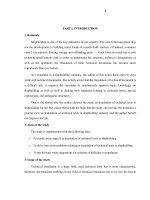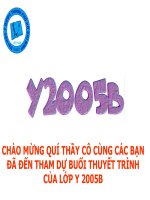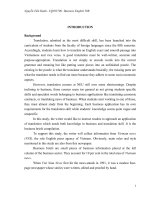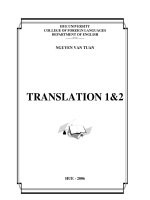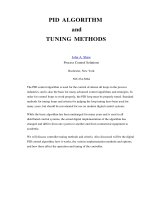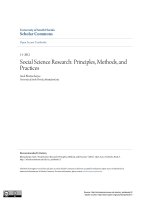Translation methods
Bạn đang xem bản rút gọn của tài liệu. Xem và tải ngay bản đầy đủ của tài liệu tại đây (10.4 MB, 22 trang )
Translation
Methods
Peter Newmark. (1988). A textbook of translation.
New York: Shanghai Foreign Language Education Press.
Group 8
Le Thi Nu
Nguyen Thi Bich Thao
Nguyen Thi Thanh Binh
Nguyen Thi Thu Giang
Introduction
t
n
e
t
n
o
c
e
h
T
The methods
Comments in
these
methods
Equivalent
effect
Methods and
text categories
INTRODUCTION
What is the meaning of method of translation?
We can defined it as ‘ the way we translate,
whether we translate literally or freely, the
words or the meaning , the form or content , the
letter or the spirit , the manner or the matter, the
direct meaning or the implied meaning, and so
on.
Writer on translation have suggested different
methods based two major old-new methods of
translation, LITERAL and FREE.
Word –
for- wo
rd
transla
tion
Literal
translation
Semantic
translation
8
Translation
Methods
Peter Newmark
Faithful
translation
Idiomatic
translation
Adaptation
Free
translat
ion
Communication
translation
Source Language
Target Language
Word –for- word
emphasis
emphasis
translation
Literal translation
Faithful
translation
Semantic translation
Adaptation
Free translation
Idiomatic translation
Communication translation
Word - for - word translation
Interlinear translation
SL word order is preserved
Words are translated by their most common
meaning, no context involved
Cultural words are translated literally
It is used to understand the mechanism of
SL
Literal translation
SL grammar constructions are
translated to the nearest TL
equivalent but still translated out
of context
Faithful translation
Reproduces exact
contextual meaning
of the original
Tries to be faithful
to intentions of the
writer
Uncompromising and
dogmatic translation
Semantic
Translation
Opposite to faithful, it
takes
into account the aesthetic
value, even compromising in
meaning
and
flexible
translation
Adaptation
The most literal form of translation
Used for plays, comedies and poetry
Themes and characters are usually
preserved
SL culture is converted to TL culture
and text is re- written
Free translation
Reproduces the content without the
form of the original, uses paraphrasing
Idiomatic Translation
Reproduces the message but
distorts nuances by using
colloquialisms and idioms
Communicative translation
Reproduces exact contextual meaning
trying that the content and language are
comprehensible to the reader
Semantic and Communicative translation fulfil the two main
aims of translation, accuracy and economy, which meets the
demand of translation.
Comments
in these
methods
Semantic and communicative translation treat the following
items similarly : stock and dead metaphors, normal collocations,
technical Terms, slang, colloquialism standard notices, phaticisms,
ordinary language.
Semantic and communicative translation can not be separated in
translation.
Semantic translation is typically seen to be focused in it original as there is disappearance of both cognitive and yet “ Baudelaire’s
translation Poe is claimed to be a special case: a communities
translation is more advantageous than the original version. At a
pinch, a semantic translation has to interpret, a communication
translation has to explain. Just possibly, a semantic translation aims
to interpret whilst communication translation gives priority over the
explanation.
Equivalent
effect
- It has sometimes been said that the
overriding purpose of any translation should be
to achieve 'equivalent effect, i.e. to produce the
same effect I 'or one as close as possible on the
readership of the translation as Has obtained on
the readership of the original. This is also called
the 'equivalent response' principle. Nida calls it
"dynamic equivalence”. As I see it, 'equivalent
effect is the desirable result, rather than the aim
of any translation, bearing in mind that it is an
unlikely result in two cases: (a) if the purpose of
the SL text is to affect and the TL translation is
to inform (or vice versa); (b) if there is a
pronounced cultural gap between the SL and the
TL text.
In the communicative
translation of vocative texts
equivalent effect is not only
desirable, it is essential; it is
the criterion
In semantic translation
The first problem is
serious imaginative
literature
Secondly, whilst the
reader is not entirely
neglected, the Translator
is essentially trying to
render the effect the SL
text
Equivalent effect is
an important intuitive
principle which could
be tested
Metho
d
s
Considering the application of the two translation methods
semantic and communicative to the three text-categories,
suggest that commonly vocative and informative texts are
translated too literally, and expressive texts not literally
enough.
AND
t
x
e
T
cate
g
orie
s
In expressive texts, the unit of translation is likely to be
small, since words rather than sentences contain the finest
nuances of meaning; further, there are likely to be fewer
stock language units colloquialisms, stock metaphors and
collocations, etc.
The translation of vocative texts immediately involves
translation in the problem of the second person, the social
factor which varies in its grammatical and lexical reflection
from one language to another.
1. Service Translation: It translates from one´s
language of habitual use into another language.
Other
methods
2. Plain prose translation: The reader can
appreciate the sense of the work without
experiencing equivalent effect.
3. Information translation: It convers all the
information is a non- literary text.
4. Cognitive translation: It reproduces the
information in a SL real converting the SL
grammar to its normal TL transpositions.
5. Academic translation: It reduces an original
SL text to an elegant idiomatic educated TL
version.
THANK YOU!
HAVE A NICE DAY!
^.^
